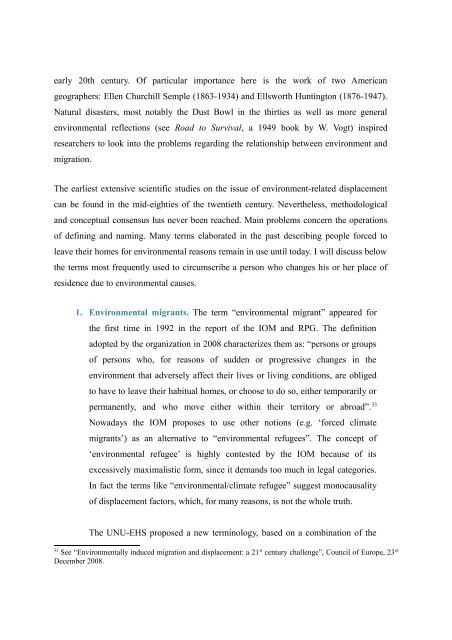Bogumil Terminski Environmentally-Induced Displacement ... - Cedem
Bogumil Terminski Environmentally-Induced Displacement ... - Cedem
Bogumil Terminski Environmentally-Induced Displacement ... - Cedem
- No tags were found...
Create successful ePaper yourself
Turn your PDF publications into a flip-book with our unique Google optimized e-Paper software.
early 20th century. Of particular importance here is the work of two Americangeographers: Ellen Churchill Semple (1863-1934) and Ellsworth Huntington (1876-1947).Natural disasters, most notably the Dust Bowl in the thirties as well as more generalenvironmental reflections (see Road to Survival, a 1949 book by W. Vogt) inspiredresearchers to look into the problems regarding the relationship between environment andmigration.The earliest extensive scientific studies on the issue of environment-related displacementcan be found in the mid-eighties of the twentieth century. Nevertheless, methodologicaland conceptual consensus has never been reached. Main problems concern the operationsof defining and naming. Many terms elaborated in the past describing people forced toleave their homes for environmental reasons remain in use until today. I will discuss belowthe terms most frequently used to circumscribe a person who changes his or her place ofresidence due to environmental causes.1. Environmental migrants. The term “environmental migrant” appeared forthe first time in 1992 in the report of the IOM and RPG. The definitionadopted by the organization in 2008 characterizes them as: “persons or groupsof persons who, for reasons of sudden or progressive changes in theenvironment that adversely affect their lives or living conditions, are obligedto have to leave their habitual homes, or choose to do so, either temporarily orpermanently, and who move either within their territory or abroad”. 33Nowadays the IOM proposes to use other notions (e.g. ‘forced climatemigrants’) as an alternative to “environmental refugees”. The concept of‘environmental refugee’ is highly contested by the IOM because of itsexcessively maximalistic form, since it demands too much in legal categories.In fact the terms like “environmental/climate refugee” suggest monocausalityof displacement factors, which, for many reasons, is not the whole truth.The UNU-EHS proposed a new terminology, based on a combination of the33See “<strong>Environmentally</strong> induced migration and displacement: a 21 st century challenge”, Council of Europe, 23 rdDecember 2008.
















